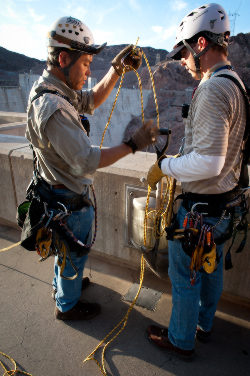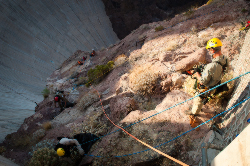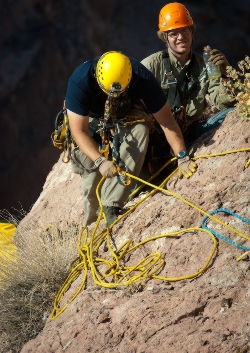Part 2: Rope Access Team applies
modern concepts to ancient craft, defying gravity
|
|||
| Photo Gallery | |
Rope Access Team applies modern concepts to ancient craft, defying gravity
Editor's note: The following article is part two of a two-part series, part 1.

Recently, a group of Lower Colorado Region employees, who together comprise the Region's Rope Access Team, were applying their specialized skills at Hoover Dam to monitor and inspect the stability of the rock prior to an upcoming contract.
This work meshes nicely with the definition of rope access work, according to the Society of Professional Rope Access Technicians (SPRAT), which states it is ". . . the use of ropes and specialized hardware as the primary means of access and support for workers. Rope access technicians descend, ascend and traverse ropes for access and work while suspended by harness or a work seat."
"Our team size is typically about six to eight people based on our experience in optimizing efficiency," said Reclamation Rope Team member Scott Foster, Dam Safety Program Manager in the Engineering Services Office (ESO).
In addition to Foster, who was the Lower Colorado Region Team Leader for the past four year, members of the Region Rope Team include Board Vice Chairman and Team Leader Rodney Tang of the Phoenix Area Office, and Corey Dickson, Nathaniel Gee, Jonathan Sanchez, and Brandon Barrow from the Regional Office.

"The team needs a minimum size to be effective and able to mobilize and respond in critical emergencies but funding a very large team is not cost effective and doesn't allow personnel to maintain proficiency (hours on rope)," said Foster.
"Other Regions have larger teams, (and have more dams to inspect) but the Lower Colorado Region has always had some of the more experienced rope access technicians in Reclamation," he added. No contractors in America have rope teams with the experience and diverse depth of those found in Reclamation. The team requires a diverse set of technical and professional skills including civil and mechanical engineering, geologists and personnel proficient with the use of hand tools, Foster explained.

Typical constraints that determine if an employee can participate with the team include the employee's availability to volunteer for rope work while continuing to perform core job functions.
Personnel must be physically fit and pass medical fitness tests. Logically, they must be comfortable with working at height.
Additionally, Reclamation Rope Access Guidelines, formally published in 2004, require a minimum of 32 hours of training per year.
"We try to incorporate training into our actual work to optimize our training opportunities and keep training/rescue scenarios very realistic," said Foster. "Having Hoover Dam in our back yard is ideal.Hoover has served as a training site for many rope access teams and been featured in rope articles and programs including National Geographic's World's Toughest Fixes."
"Reclamation has never had a lost time accident using rope access with tens of thousands of hours of work on rope," he added.
Webmaster: sha-lcr-webcomments@usbr.gov
Updated: July 2, 2013

